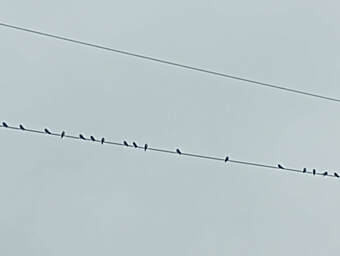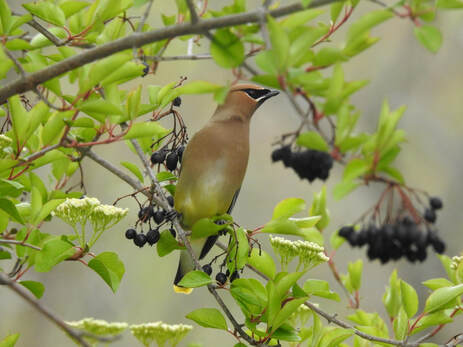 Tree swallows on the power line; Credit: Charlene Uhl Tree swallows on the power line; Credit: Charlene Uhl Sycamore Grove Farm, Madison County Our farm attracts several members of the swallow family – barn swallows, purple martins and tree swallows. They are most active early in the morning and at dusk – or when my husband stirs up the bugs as he mows. The most dramatic of the three is the tree swallow (Tachycineta bicolor)--both for its iridescent blue green back and brilliant white chest as well of the size of the flocks that arrive in mid-summer as they congregate for the fall migration. At this time of year, I easily see 50-75 swallows sitting on the electric lines that cross our field and line the driveway of our neighboring farm. These are the early migrators. The most I have counted this year is 250 – and when I recorded on eBird, I was “asking” to explain this high number. Last year the highest count I recorded was 500 swallows. It was later in the summer and closer to the time the majority of swallows had begun their migration Tree swallows can be found along coastal beaches, freshwater ponds and lakes and agricultural fields. They are voracious insect eaters and can be seen displaying their aerialist skills when a storm is brewing and the wind brings insects up above the ground. They eat all kinds of flying insects, as well as spiders and mollusks. The size of their prey ranges from smaller than a grain of sand to up to 2” long. They chase prey with acrobatic twists and turns, which is how they got the nickname “aerialist in tuxedo.” Virginia is in the southernmost area where tree swallows breed. Large numbers migrate deep into the northern part of Canada to breed. Tree swallows are cavity nesters, as we discovered when they commandeered one of our bluebird houses last year. And their nest was exquisitely lined with white feathers. They are known for traveling great distances to find dropped feathers to line their nests. They have also been observed playing with dropped feathers, chasing after them before taking them into the nest box. Nest predators are the same ones that frequently raid cavity nests: snakes, raccoons, bears, feral cats and the like. While they are not considered endangered, their populations have declined slowly over the last 50 years due to the disappearance of natural cavities. They have also shown a sensitive response to climate change. The average life of a tree swallow is 2.7 years. They have a low first-year survival rate – 79 percent do not survive that first year. The oldest tree swallow recorded was twelve years old. If the increasing numbers of tree swallows on our farm is any indication, their southern migration is starting. So keep an eye out for these delightful acrobats in the air! Happy birding! Charlene
0 Comments
Your comment will be posted after it is approved.
Leave a Reply. |
Have a blog or blog idea?
Let us know (click) Other Blogs
VA Native Plant Society - click Brenda Clement Jones - click John Muir Laws' Blog - click Megan's Nature Nook - click Categories
All
Archives
September 2023
Blog Administrator:
Kathleen A. VMN since 2018 |
